Wheaton, IL. Takis, the permit clerk, always seemed to be on a cigarette break, but one of my dozens of early morning phone calls finally made it through. So it was that I secured a permit to enter the Holy Mountain as a non-Orthodox Christian. Ouranoupoli (literally “Heaventown”), a small coastal village about an hour’s bus ride from Thessaloniki, is the embarking point for the monastic enclave of Mount Athos. There I proudly displayed my hard-won permit at the Pilgrim’s Office and purchased a ferry ticket. This, along with my gender, was all I would need to secure a free three-night stay.
I shared the massive boat with a smattering of monks and pilgrims. After an hour, the first of the hallowed structures appeared, the Russian monastery of St. Panteleimon. For a peninsula inhabited entirely by men, I hadn’t expected so many pastel tones. Green onion domes surmounted by yellow crosses enhanced the fortress’s white and turquoise walls. The monastery was the site of an early-twentieth century theological controversy over the name of God that required the intervention of a Russian gunboat. Vladimir Putin, I learned from a fellow ferry passenger, had made a celebrated appearance at this monastery just the year before my trip. I once met a Moscow monk who proudly boasted to me that the Orthodox church happily blessed the ambitions of Putin, just as some medieval Christians had blessed the efforts of the aptly-named Byzantine emperor, Basil the Bulgar Slayer. But this conversation would soon be offset by Mount Athos. Hearing my complaint about nationalism, an Australian monk said to me with a smile: “Really, the only truly Orthodox are not the Russians, the Serbs, or the Greeks—but the saints.”
As if to anticipate that insight, the clouds that concealed my vision from the ferry soon spread like a curtain to reveal what had been hitherto invisible: a towering, absurdly triangular peak. Legend has it that when the Virgin Mary was attempting to visit her friend Lazarus on the island of Cyprus, accompanied by the apostle John, her ship landed near this mountain after being blown off course. She converted the residents and claimed the land for her son. Whether or not this in fact “happened,” as a modern historian might wonder, it happened nonetheless. Mount Athos became an established monastic enclave by the year 1000, adding considerable altitude to the tradition of monastic prayer that first flourished in the flat Egyptian sands. So it was that this mountain became Mary’s spiritual garden. The icons of Athos, as one scholar nicely put it, are its flowers.
The boat docked at the main port of Daphne, a village about as large and unassuming as Ouranoupoli. Boarding a smaller ferry, I glided past the famous “cliffhanger” monasteries like Simonopetra (Simon’s rock). Legend relates that the Virgin Mary told Simon exactly where she wanted this monastery to be constructed. On seeing it for the first time perched over one-thousand feet above the shoreline, I imagined Simon asking Mary if she might reconsider. And yet, for all the architectural ambition on display here, there was nothing unnatural about this cliff-perched dwelling, with its precarious walkways supported by diagonal beams. These tiny monastic kingdoms were as integrated with the peninsular rockface as Frank Lloyd Wright’s Falling Water is with the river it surmounts.
I disembarked at St. Paul’s Monastery and backtracked on a beautiful but punishing one hour hike to my first reservation at Dionysiou monastery. Finding myself alone on the beach, I picked up a stone that sits on my desk to this day, a reminder of the necessary renunciations upon which adult life is founded. I was welcomed through the ancient gate, enhanced with five-hundred-year-old hardware. Upon arriving I was treated to the traditional libations, a shot of tsipouro and loukoumi (Turkish delight). The sweetness assuaged the liquor’s refreshing burn.
I immersed myself in the exterior frescoes depicting the apocalypse with the daylight that was left. Some say these sixteenth-century frescoes foretell nuclear war, and the resemblance of one image to a mushroom cloud is really quite remarkable. Others say these images are inspired by Protestant prints (an unpopular theory on Athos, but a true one). A German pilgrim, himself a Catholic, glad to find a non-Greek visitor, warned me to brace myself for the rudeness that I should expect as a non-Orthodox visitor. He was right. Sometimes I was required to eat alone. I received more than a few dismissive remarks. “Do you know what you’re looking at?” spat one monk to me with a sneer as I examined the frescoes at Great Lavra. I tried to answer but he walked away.
But the burn of such suspicion only made the eruptions of Athonite hospitality all the sweeter. For every monk who treated me like the intruding American that I was, there was another that welcomed me like a lost son. One monk at the Skete (that is, smaller monastery) of St. Andrew, refused to allow me to pay for an icon of the Christ child borne by St. Christopher, patron of travelers, an icon which now greets any visitors to my home. Another white-bearded monk, realizing my interest in icons, forced me to take two dozen large and beautiful prints of all of the icons in the monastery store, and refused to take any payment. The almost maniacal munificence in his eyes assured me there was nothing I could do but accept.
The icons are why I had come, which in part explains how my most unexpected encounter on the all-male monastic peninsula was with a woman. To interview an iconographer I had been told about, I made a stiff hike up to the Skete of St. Anne. I passed a few pack donkeys along the way and a helipad constructed (I was told) for the visits of Prince Charles. I entered the humble studio of a kind and elderly monk with a white beard nearly down to his knees. We discussed the process of making icons, but he aimed to introduce me to someone else. He directed me to the Skete’s central church. Its cherry-red dome was framed by the impossibly blue Aegean. Each of the monasteries of Athos have a central church like this one, known as the katholikon. The elderly artist monk urged me to enter the cool, darkened space alone.
I expected I was the only person in the space, until I sensed another presence emanating, inexplicably, from the icon of St. Anne. Her face was blackened from centuries of devotional candles. The instinct of an art historian might be to accurately date it, or even to clean it. This was a welcome thought that put me safely in the driver’s seat of this encounter. But then all such ambition evaporated, and it felt more like the icon wanted to clean me. I looked into Anne and Mary’s blackened faces. With enough prayer and candle smoke, I suppose every icon is on its way to becoming black.
I was then thirty, without the ability to sit in meditative silence for more than ten minutes at a time. Therefore, having “seen” the icon, checking this box on a travel to-do list, I suppose my goal had been met. I wish I had stopped to notice how black Anne was festooned with grateful golden offerings from penitent men; how her tiny daughter seemed impatient to embrace her vocation to carry the Creator in her womb and in her arms. I wish I had noticed how their matching red regalia and fiery manes of gold suggested that our lesser passions need not be extinguished so much as taken up into a higher passion for God. Instead, I retreated outside to look out over the far less demanding sea.
I asked a passing monk about the icon. “Who is Saint Anne?” I inquired in very rudimentary Greek. He looked at me with incredulity, amused more than annoyed by my ignorance, and kindly replied, “ee yiayia tou Iesou.” Which is to say, using the Greek slang for grandmother, Jesus’s Yiayia. This dimension of Jesus’s life was entirely left out of my Protestant education, which is probably why it hit home. It comes from the Protevangelium (literally proto-gospel) of James, a second-century “prequel” of sorts to the Gospel of Luke. This charming novella reveals that Anne and her husband Joachim, soon-to-be parents of the Virgin Mary, were in fact infertile. In a moving complaint, Anne challenges God who makes the birds and the beasts fruitful while leaving her barren. God hears her cry and grants a child, who is immediately dedicated to service in the Jewish Temple, even though Mary is a girl. Anne and Joachim drop their daughter off at the Temple, and Mary the toddler signals her assent by joyfully dancing. The young Mary’s daycare facility was the Holy of Holies itself.
The fact that Mary had been fed by angels while residing in the Temple might explain why she was not terribly surprised when one later appeared to her announcing that she would give birth to Christ. The Protevangelium adds other fascinating and poetic details to the traditional Gospel story. When Gabriel appeared to her, it turns out, Mary was busy with the task of weaving the Temple veil. Which is to say, Mary was generating the boundary between humanity and God just as God was overcoming it. According to tradition, the weaving of God’s life within Mary’s womb commenced on March 25. Nine months later to the day, Christ was born, making Mary the mother of God, and Anne—it naturally follows—the grandmother of God.
Days later I was at the Georgian monastery of Mount Athos, Iviron, overlooking the eastern side of the peninsula. Iviron is the spot where Mary had made landfall with the Apostle John, and I was about to learn of her second trip to the peninsula. Legend has it that when the Byzantine Empire turned to destroying images, this image was cast into the sea by a pious widow hoping to preserve it from destruction. The icon skipped across the ocean from Constantinople to find refuge on Mount Athos. She parked on the waves outside the Iviron monastery, but as monks approached her, she retreated like a frightened refugee.
Finally a hermit named Gabriel successfully approached the icon by walking on water, as if to suggest that the Annunciation from the angel Gabriel did not just happen once, but happens over and over again in the souls of those who take the risks of faith. The icon, having permitted itself to be handled, was placed in the main church, but in the morning she was gone. They searched frantically, only to find her hanging on the monastery gate. The third time this happened the monks got the message and built a chapel for her there (hence her name Portaitissa, “Gate-Keeper”). “I have not come here for you to guard me,” she told the monks, “but for me to guard you.”
Upon my arrival at Iviron, I soon found myself with about thirty monks crowded into a small chapel singing to the Gatekeeper. As the monks dispersed following the chanting, I stopped to study her a bit longer. She was bedecked—like the icon of St. Anne—with the offerings of pilgrims, anything from medieval jewels to modern men’s watches. Both images were lovingly encased in silver and gold revetment, a way of showing special honor to icons. Despite these coverings, Mary and her son’s faces were exposed, a fact not to be taken for granted. Sometimes, as with the Kykotissa icon that resides in the mountains of Cyprus, even the faces are concealed by revetment. There after an early morning liturgy, having read the stories about what these icons were capable of, I considered the concealment to be for my protection.
But the keepers of the Gatekeeper icon were willing to take the risk of showing some skin. As if to confirm the family connection to St. Anne, Mary and Jesus’ faces have a deep brown hue, en route to black as well. Mary bore a scar on her right cheek and her chin, presumably from when she was attacked by an iconoclast (icon-breaker) just before her Mediterranean voyage. To his surprise, blood flowed from the wound. What better picture, I thought, for a Protestant studying icons. These sacred images had been disdained, even attacked, by my branch of the Christian tradition, and I was thankfully in a position to make amends.
Upon my return to Wheaton, Illinois, where I now teach art history, I saw an Orthodox friend announce on Twitter that he had at last reached the Holy Mountain. I was not envious, as I had reached a new outpost of prayer myself. Instead of pining to return to the Mediterranean, I have recreated the Mediterranean (from medius “middle” and terra “land”) in the middle of my own continent, this place known as the American Midwest. Just as Athos itself was a recreation of the monastic outpost of Egypt, so have I audaciously imitated Athos in Illinois. The paper replica of the Portaitissa looks out on the Wheaton quad from my office window, now bleached by the sunrise. The icon of St. Anne is at the center of a small icon corner in my office, enhanced not only with ancient Greek icons, but with Christian Native American icons of the Great Lakes as well.
And then there is my classroom itself, where the Art Department constructed another icon corner, at the center of which is the famous Sinai icon of Christ. Over the years, what was once just an icon corner has morphed into an entire wall of icons. Indeed, it is beginning to resemble a full-scale Russian iconostasis. Many of them are replicas of icons from Mount Athos, enjoyed—in Wheaton at least—by both women and men. Sometimes I have seen students seated in front of the images when the classroom is not being used. One student, frustrated that we had run out of incense for the little chapel, anonymously dropped off a new package of incense to remind me to keep it up.
To date, there have been no miracles in front of these machine-made icons (and until we can afford hand-painted ones, the machines will have to do). While we have transposed multiple campus controversies and national tragedies into the register of the Psalms in front of these images, God’s faithfulness has not yet been marked—as it has been with some Athonite icons—through dramatic healings or the oozing of myrrh. This might be considered a serious deficiency, for Athos, beyond the stories already mentioned, has miracles to spare.
My favorite has to do with the Axion Estin (“it is worthy”) icon that enhances the main church of the Athonite peninsula, the Protaton. Like her sister the Portaitissa, she too is concealed by silver revetment and enhanced by the offerings of pilgrims, including dangling watches that range from Timex to Rolex. If Gabriel the monk had rescued the Portaitissa, the archangel Gabriel himself, it is said, once visited the Axion Estin disguised as a monk. Perhaps Gabriel was nostalgic for his original errand to Mary. On his surprise visit, Gabriel added a verse to a traditional hymn, which began with the words the icon bears today, Axion Estin. The monks who witnessed the visit, in addition to noting that Gabriel had an especially melodious voice, asked the angel in disguise to write the verse down. Gabriel accommodated them by writing it on a roof tile so it would not be forgotten, which it has not been. The legend is so beloved by Greece that it has spawned Nobel Prize winning poetry and song.
Impressive as such heavenly intervention may be, something distantly similar did occur in our imitation Art Department Athos. We began to host morning and evening prayer services in our little icon corner during Advent and Lent. After about a few years of doing this, on one occasion, I was the only person who showed up, and remarked to myself that it was the first time ever that I had been alone. But just as I was finishing the prayer service, someone walked by and joined me. I would like to report that he was the angel Gabriel in disguise, but in fact I knew him. But either way, without any cajoling, the services have yet to be conducted solo.
This can hardly be considered miraculous, but there was one event in our chapel so far that nearly was. One year I decided I was too weary to keep the Lenten services going. On the very day the services would have begun, Ash Wednesday, I received in campus mail a hand-written letter from Munich. I opened it up to read a note from a student who had graduated the previous year and was now a Fulbright scholar. In the letter, she thanked me for hosting the Advent and Lenten services because they had been so formative for her. Needless to say, I got the message and promptly resumed the voluntary services again, and the students keep showing up. Perhaps it is the icons that keep them coming back.
As we resume our prayers in Lent this year, we have a war-wracked world to pray for. I have Orthodox friends that find our little chapel concerning, and they are certainly right that a casual use of icons for decorative enhancement is to be avoided. Still, their chief complaint should be directed to the monks of Mount Athos who, infused with God’s flagrant generosity, so recklessly gave their replica icons away.
—
(Photographs by author.)

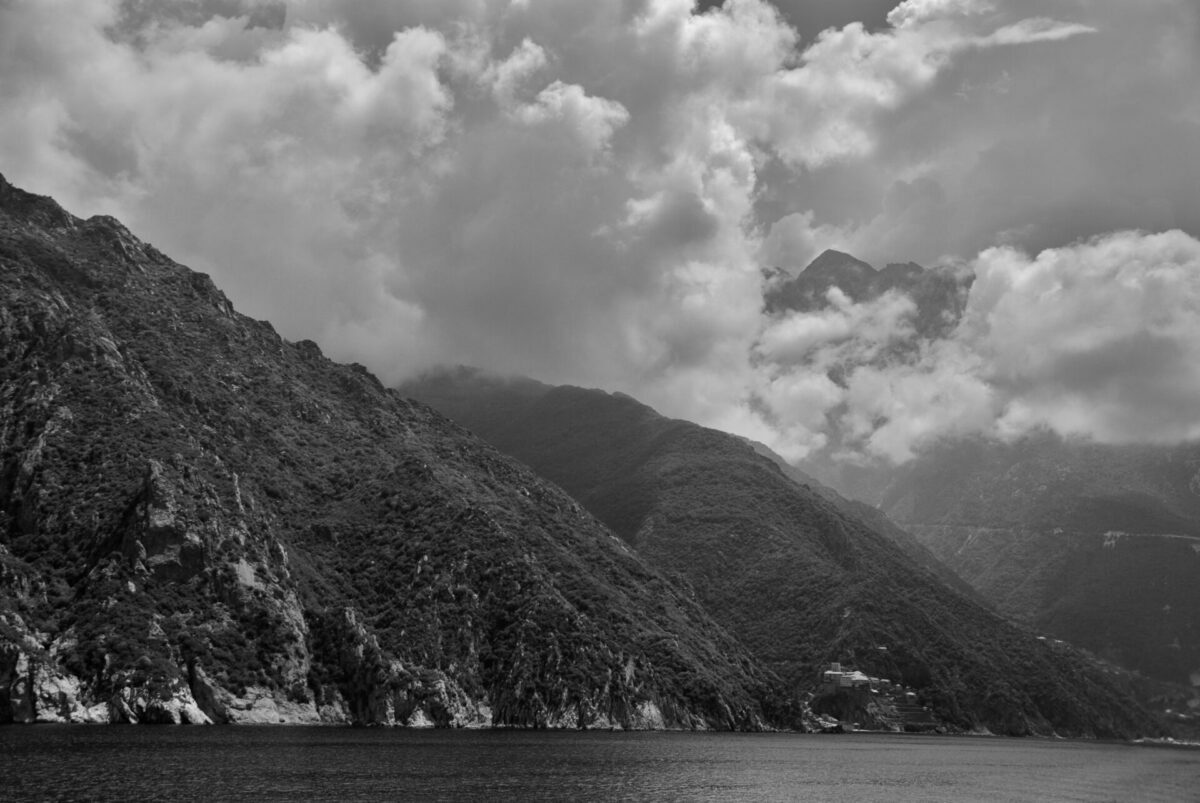
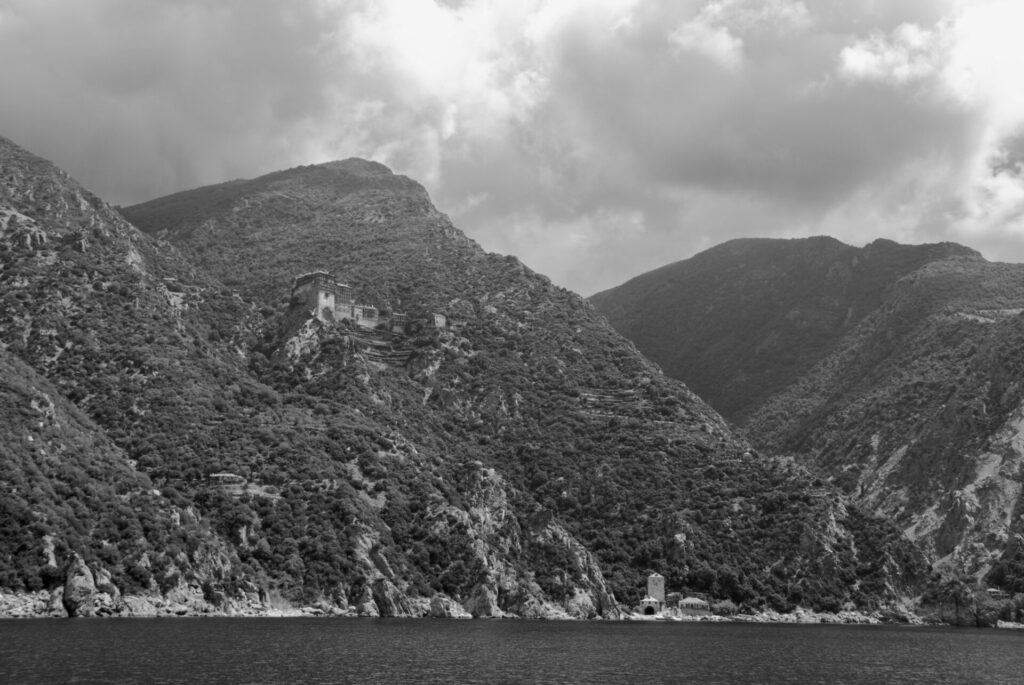
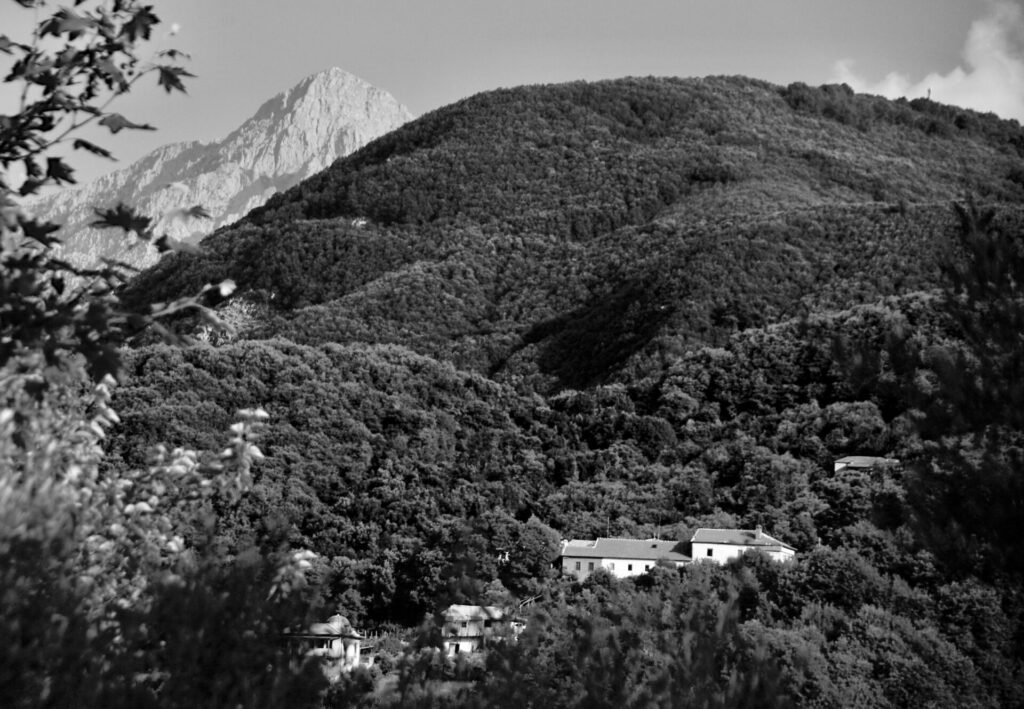
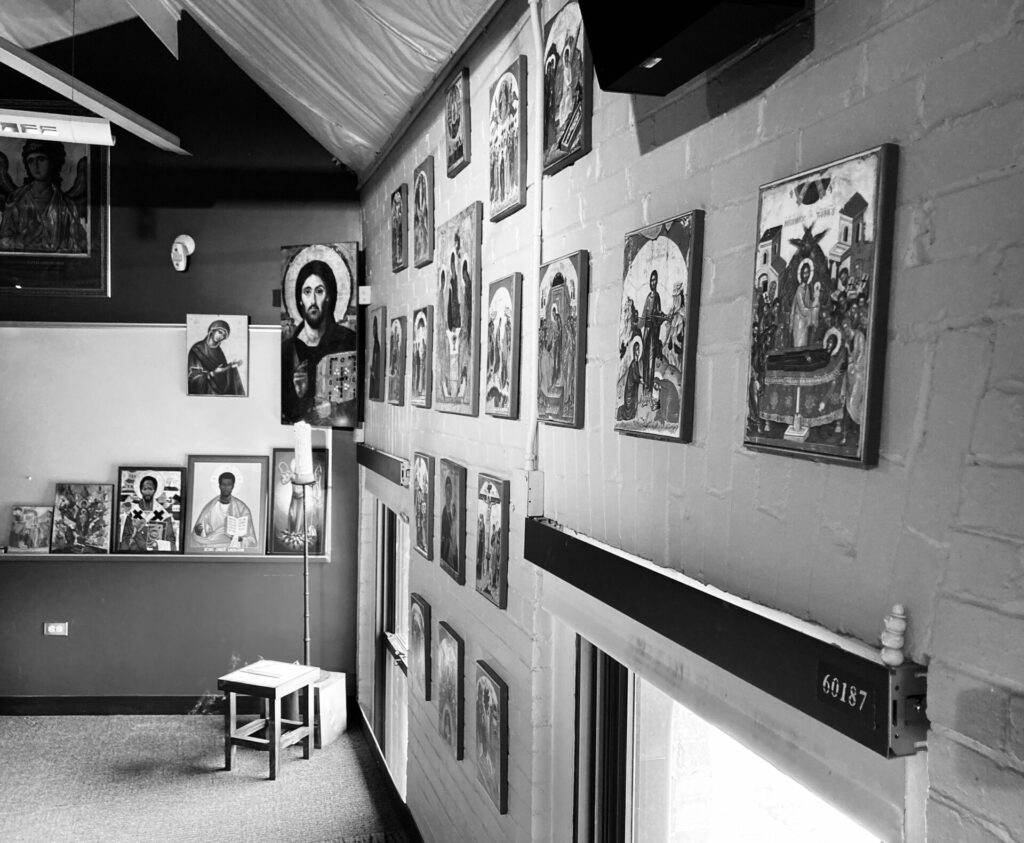

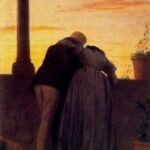

2 comments
Fr Gregory Matlak
A beautiful reflection, Matthew. Thank you.
I, too, was blessed, insignificant as I am, to meet St Anna at her Skete on the Holy Mountain. We believe that prayers offered one night there led to the gift of our first adopted daughter. Not so long later, that daughter herself then prayed bedside for more than a year to St Anna, for a little sister. We were also able to offer similar prayers before the wonderworking icon of St Anna at St Tikhon’s Monastery. Following a truly extraordinary series of events, which cannot be recounted here, we brought home our second little one, on the Feast of the Dormition of St Anna. That week, I finally understood the impulse to leave emblems on icons–and why some Orthodox say that the Saints are more alive and active in this world than we are. Our little Anna is a bundle of joy, a gift of God, and of his dear grandmother.
Good strength in the fast, dear friend. May the Lord Jesus Christ have mercy on us both.
Reader John
I’ve only been Orthodox for 24+ years, so I could be wrong, but I believe that the Orthodox Church denies getting any of its tradition from the Protevangelium of James, which likelier records the tradition than forms it.
It’s an easy mistake to make, though, and you’ll find many Orthodox Christians (perhaps influenced by the Protestant insistence on “where did you get that idea!?”) who’ll make it.
Comments are closed.